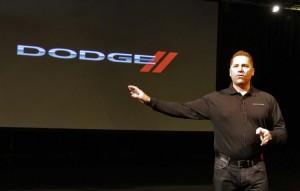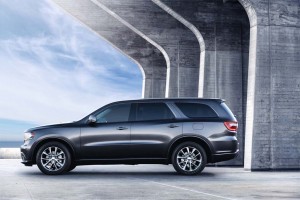Despite some uncertainty over its future product program, the Dodge brand isn’t going away, insists the man in charge of coming up with its long-term strategy.
Having dropped such brands as Eagle and Plymouth over the years, there’s been growing speculation in recent months that Dodge would also be sent off to the automotive rust heap, especially after documents leaked out suggesting some of the brand’s key products might not be around for more than a few years.
But that only suggests that Dodge, like the rest of the Chrysler Group, is trying to get a better handle on its overall line-up and end product duplication – badge engineering, in industry-speak – insists Tim Kuniskis, the President and CEO of the Dodge brand.
Getting rid of Dodge, “is not a part of a master plan to consolidate brands,” the executive said during a media preview of the new 2014 Dodge Durango in suburban Los Angeles.
(Check out all the intros and unveilings at the 2013 Frankfurt Motor Show. Click Here.)
That doesn’t mean it will be business-as-usual, cautioned Kuniskis. Sergio Marchionne, who serves as CEO of both Chrysler and its Italian partner Fiat, is intent on working up a more effective product program that eliminates duplication among the various brands. It is expected, for example, that only one of the two Chrysler minivans will remain in the portfolio when it’s time for an update a couple years from now, and the speculation favors the Chrysler Town & Country model.
On the other hand, Marchionne has hinted that he would like to find an alternative “people-mover” concept to replace the current Dodge Caravan.
Brand boss Kuniskis declines to discuss future Dodge products in detail, but in a discussion with TheDetroitBureau.com, he said the challenge will be to come up with a good business case to maintain at least some existing models and add new ones.
The eventual size of the Dodge portfolio “remains to be seen,” adds Kuniskis, who previously headed Fiat’s U.S. operations and helped the brand overcome early problems with its American return. In the long run, Dodge “could (have) fewer” products, but it’s also possible there “could be more. What determines that is our ability to define opportunities in the marketplace.”
(GM unveils new full-size SUVs in simultaneous NY/LA previews. Click Here to see the new 2014 Chevrolet Silverado and Tahoe and GMC Yukon lines.)
Founded by brothers John Francis and Horace Elgin Dodge, the division will celebrate its 100th anniversary in 2015. Making that centennial seemed like a longshot just four years ago as parent Chrysler plunged into bankruptcy, emerging only after Fiat agreed to take control of the struggling Detroit maker, triggering a mult-billion-dollar federal bailout.
But Dodge’s fortunes have improved significantly since then – as have those of the partner company. Through the first eight months of this year, the brand best known for muscle cars like the Charger and Challenger has sold 400,000 vehicles, Kuniskis forecasting it will top the 600,000 mark by year-end. It has continued to outpace the U.S. auto industry’s overall pace of recovery, in fact, and remains the top-selling brand among the Chrysler Group divisions for the 17th consecutive year.
Dodge also delivers some of the demographic numbers that make a compelling case to keep it in the brand portfolio, according to the divisional CEO. Among other things, it has an average buyer age of just 48 years old, a decade below the industry average and a year younger than the typical buyer at Honda, generally seen as one of the most successful brands when it comes to winning over youthful consumers.
That said, Dodge does have its challenges, according to industry observers. And that goes beyond the declining market for minivans. It will have to differentiate other models to minimize badge engineering. And it has to find ways to either replace its key muscle cars – like the Challenger and Charger – or deliver the same levels of power and performance while meeting increasingly stringent U.S. fuel economy requirements.
The new Durango is a sign that Dodge is taking mileage mandates seriously. Even the V-8 version of the 2014 full-size SUV gets a full 15% bump in its EPA rating. That said, Dodge has a lot of work to do to meet not just the upcoming 2016 Corporate Average Fuel Economy numbers but the 54.5 mpg target for 2025.
But for skeptics, Kuniskis says they should be betting on Dodge to stick around. “It has a very solid future.”



Fiat will use the Dodge and Chrysler name plates on imported Fiat models to up their sales volume at the expense of the Chrysler and Dodge brands which will eventually be displaced. Dodge and Jeep will stay as Fiat doesn’t have anything to replace them with though they will use as many Fiat parts as Marchionne can plug into them.
It will be a slow but similar process to the Chinese invading big box U.S. stores with crap. If you go to Home Depot, Wal-Mart, K-Mart, etc. you will find about 75% or more of the products sold are Chinese crap. Eventually Dodge and Chrysler will be the same except with Fiat crap.
Ironic, ain’t it? Durango is a badge-engineered Grand Cherokee which was begat from…what’s that, Dieter? You’re trying to forget your years shacked up with Chrysler?
The Dodge Durango is not “badge-engineered,” it shares a platform with the Grand Cherokee. “Badge-engineering” assumes more shared parts, like the minivans.
I spent the day on the Interstate while this was being read, and if the number of Chargers between Norfolk VA and south GA is any indication, Dodge has sold a pot-load in good-old-boy country. Almost impossible to pick out Troopers, which all have them.
But watching Dodge Journeys, rebadged as Fiat Freemonts, in my neighborhood in Palermo, Italy is the most amazing tribute to Dodge. They can barely get through the streets, but people are buying them. Of course, over there both it and the Dodge/Chrysler minivan both come with a turbodiesel which suits them much better than the choices of engines we have here.